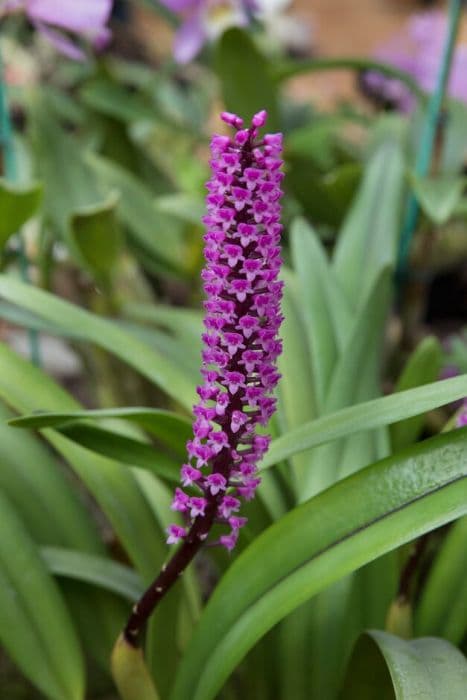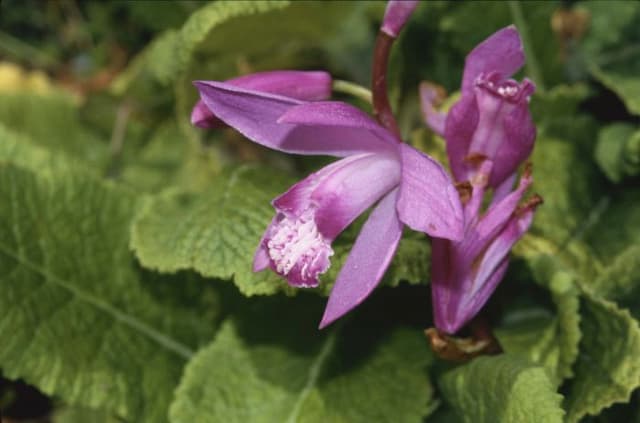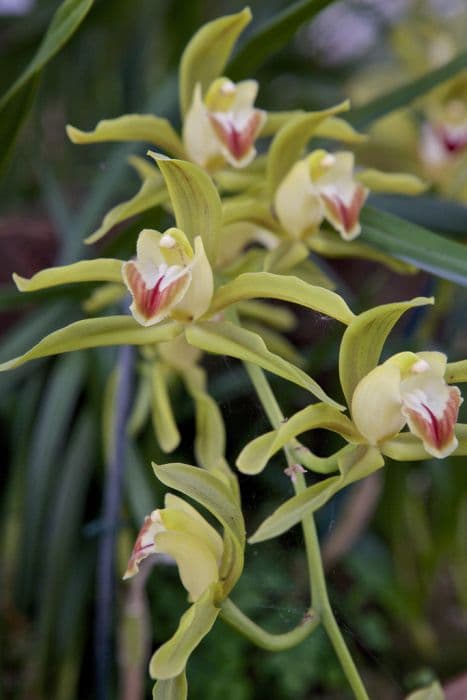Noble Dendrobium Dendrobium nobile 'Cooksonianum'

ABOUT
The plant in question, known commonly as the Noble Dendrobium, showcases an elegant and exotic appearance that is much revered in the horticultural world. Its long, cane-like stems provide a sturdy backdrop for the striking flowers that emerge. These blossoms are often a captivating mix of white and purple hues, though the exact shade can vary from plant to plant. The flowers themselves boast a classic orchid shape, with a prominent lip that often showcases a different color or pattern, providing a stark contrast that catches the eye. The leaves of the Noble Dendrobium are thin and oblong, with a glossy green surface that complements the bright flowers. During the blooming season, the plant becomes a spectacular display of color and form, with multiple flowers that can emerge from the nodes along the stems. The visual impact of its floral presentation is both delicate and striking, a true testament to the diversity and beauty found within the world of orchids. It's also worth noting that this particular variety, with its distinguished flowers, is a favorite among orchid enthusiasts. Its ornate appearance makes it a popular choice for decorative displays in homes and botanical collections. The blooms of the Noble Dendrobium are not only beautiful but are also relatively long-lasting, extending the enjoyment of their ornamental presence. Overall, this plant embodies the essence of tropical elegance and horticultural sophistication.
About this plant
 Names
NamesFamily
Orchidaceae
Synonyms
Noble Dendrobium, Cooksonianum Dendrobium, Cook's Dendrobium
Common names
Dendrobium nobile var. cooksonianum, Callista nobilis, Dendrobium coerulescens var. cooksonianum, Dendrobium nobile var. nobilius.
 Toxicity
ToxicityTo humans
Dendrobium orchids, including Dendrobium nobile 'Cooksonianum', are not known to be toxic to humans. Therefore, they are generally considered safe and do not pose a risk if accidentally ingested. There are no common symptoms of poisoning associated with these plants, as they are not poisonous.
To pets
Dendrobium orchids are also not known to be toxic to pets. Ingesting parts of the orchid is not likely to cause poisoning in pets, and there should be no symptoms of toxicity. Thus, these plants are generally considered safe around pets.
 Characteristics
CharacteristicsLife cycle
Perennials
Foliage type
Evergreen
Color of leaves
Green
Flower color
White
Height
1-2 feet (30-60 cm)
Spread
1-2 feet (30-60 cm)
Plant type
Orchid
Hardiness zones
10
Native area
Asia
Benefits
 General Benefits
General Benefits- Aesthetic Appeal: Adds beauty with its vibrant flowers and can enhance the visual appeal of any indoor or garden space.
- Hobby Interest: Growing orchids like Dendrobium can be a fulfilling hobby, offering a rewarding challenge for gardeners and plant enthusiasts.
- Gifting: Due to its beauty, Dendrobium orchids are popular gifts for special occasions.
- Longevity of Blooms: The flowers of Dendrobium orchids often last for several weeks, providing a long period of enjoyment.
- Decrease Stress: Caring for plants such as the Dendrobium can reduce stress and promote feelings of well-being.
- Symbolism: Orchids often symbolize love, luxury, beauty, and strength, making them meaningful additions to home or office.
 Medical Properties
Medical Properties- Antioxidant activity: Dendrobium nobile has been shown to possess antioxidant properties, which could help protect cells from oxidative damage.
- Anti-inflammatory effects: Components within Dendrobium nobile may have anti-inflammatory effects, potentially useful for reducing inflammation.
- Immunomodulatory potential: Some studies suggest that Dendrobium nobile can modulate immune system function, possibly enhancing immune response.
- Analgesic properties: This plant has been traditionally used to alleviate pain, indicating possible analgesic effects.
 Air-purifying Qualities
Air-purifying QualitiesThis plant is not specifically known for air purifying qualities.
 Other Uses
Other Uses- Dendrobium nobile orchids can be used in bridal bouquets and wedding decorations due to their striking and long-lasting flowers.
- These orchids can be incorporated into biodegradable flower displays or eco-friendly art pieces as they decompose without leaving harmful residues.
- Dendrobium nobile is sometimes used in educational settings, such as schools and botanical gardens, to teach botany and plant life cycles.
- The sturdy canes of the Dendrobium nobile can be used in crafting, such as making small support stakes for other plants or as a natural material in art projects.
- They are often used as a natural way to add vibrant colors to terrariums or vivariums that house reptiles and amphibians, providing a dynamic environment for the inhabitants.
- The blossoms of the Dendrobium nobile are sometimes used in perfumery, to create fragrances with a fresh and sweet aroma.
- In culinary arts, some high-end restaurants use the edible flowers of Dendrobium nobile to garnish dishes and cocktails for a touch of elegance.
- Photographers and filmmakers may utilize the exotic appearance of Dendrobium nobile orchids as a backdrop or prop in photo shoots and film scenes.
- Crafters might use dried Dendrobium nobile flowers to create bookmarks, greeting cards, or other paper-based crafts, adding a three-dimensional floral element.
- The plant can be a source of inspiration for designers and artists, who may use the shapes and colors of the orchid in fabric prints, wallpaper designs, or jewelry.
Interesting Facts
 Feng Shui
Feng ShuiThe Noble Dendrobium is not used in Feng Shui practice.
 Zodiac Sign Compitability
Zodiac Sign CompitabilityThe Noble Dendrobium is not used in astrology practice.
 Plant Symbolism
Plant Symbolism- Beauty and Elegance: Dendrobium Orchid, commonly represents beauty and elegance due to its striking and sophisticated appearance.
- Purity: The intricate and pure blooms can symbolize innocence and chastity, often associated with the pristine beauty of the flower.
- Refinement: Given the delicate nature of the orchid and its posh status among floral enthusiasts, it is frequently associated with refinement and luxury.
- Vitality: Orchids are known for their long-lasting flowers, which can often symbolize vitality and the ability to endure and thrive in various conditions.
- Charm: With an enchanting allure, the Dendrobium Orchid can symbolize captivating charm that captivates and fascinates onlookers.
- Fertility and Fecundity: In some cultures, orchids are a symbol of fertility and abundance due to their prolific nature and multitude of blooms.
- Sophistication: Their exotic and unusual appearance makes orchids a symbol for sophistication and a refined taste in aesthetics.
 Water
WaterThe Noble Dendrobium orchid should be watered thoroughly once the top inch of the potting medium is dry, usually about once a week during active growth. In the winter, when the plant is resting, reduce watering to every other week or less, depending on the humidity and temperature conditions. It's important to let water flow through the potting media and out of the drainage holes to avoid salt buildup. Typically, you might use around 8-16 ounces of water each time for a medium-sized pot.
 Light
LightNoble Dendrobium orchids thrive in bright, indirect light. An east or west-facing window is ideal, where the plant would receive morning or afternoon sun. They can tolerate some direct sunlight, especially in the morning, but during the hottest part of the day, the light should be diffused to prevent leaf burn.
 Temperature
TemperatureThe Noble Dendrobium prefers daytime temperatures between 65 to 85 degrees Fahrenheit and cooler nights, ideally in the range of 55 to 60 degrees Fahrenheit. This temperature drop is crucial for blooming. The plant can survive in temperatures as low as 50 degrees Fahrenheit at night and as high as 95 degrees Fahrenheit during the day, but such extremes should be avoided.
 Pruning
PruningPrune Noble Dendrobium orchids after they finish flowering, usually by cutting the flower spike near the base but only if it is yellowing or dead. Throughout the year, remove any dead or damaged foliage or pseudobulbs to encourage healthy growth and reduce the risk of disease. Pruning is not usually required more often than once a year, and always use sterilized tools to make your cuts.
 Cleaning
CleaningAs needed
 Soil
SoilThe Noble Dendrobium (Dendrobium nobile 'Cooksonianum') thrives in a well-draining orchid potting mix, often containing fir bark, charcoal, and perlite or sphagnum moss. Soil pH should be slightly acidic, ideally between 5.5 and 6.5.
 Repotting
RepottingThe Noble Dendrobium should be repotted every 2 to 3 years or once the potting medium begins to break down and lose its drainage capacity. It's best to repot after the flowering period.
 Humidity & Misting
Humidity & MistingThe Noble Dendrobium prefers high humidity levels, generally between 50% to 70%, to thrive and produce healthy growth and flowers.
 Suitable locations
Suitable locationsIndoor
Provide bright light and high humidity for the Noble Dendrobium.
Outdoor
Place in dappled shade, protect from frost for the Noble Dendrobium.
Hardiness zone
10-11 USDA
 Life cycle
Life cycleThe life cycle of the Dendrobium nobile 'Cooksonianum', commonly known as Cook's Dendrobium, starts with seed germination, which often requires a fungal symbiont to provide the necessary nutrients. Following germination, the seedling grows slowly, developing into a young orchid with a few leaves and possibly a single pseudobulb, which can take several years. As the plant matures, it produces clusters of pseudobulbs connected by a rhizome, each with several leaves, from which flower spikes emerge. The blooming stage occurs typically in the spring, when the plant produces its characteristic showy flowers, which can last several weeks. After flowering, a period of growth ensues where the plant focuses on producing new pseudobulbs and leaves, storing energy for the next flowering cycle. The plant then enters a period of dormancy where watering is reduced before the cycle begins anew with the next growth and flowering period.
 Propogation
PropogationPropogation time
Spring-Early Summer
The most popular method of propagating a Dendrobium nobile 'Cooksonianum', commonly known as the Noble Dendrobium, is through division, which is best done in the spring after the plant has finished blooming. To propagate by division, remove the plant from its pot and carefully separate the pseudobulbs with sterile cutting tools, ensuring each division has at least three healthy pseudobulbs. Plant these divisions in fresh orchid potting medium, ideally in smaller pots that snugly fit the roots, which encourages blooming. Maintain high humidity and warm temperatures, around 70 degrees Fahrenheit (21 degrees Celsius), to help the divisions establish. Water sparingly until new growth appears, signifying that the plant has successfully taken root.








